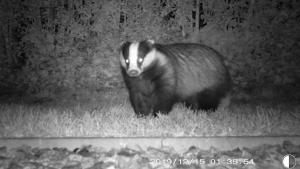The island of Ireland has fewer mammal species than Britain and continental European neighbours, a fact related to the islands deep geographical history.

Ireland became an island around 15,000 years ago, at a time when glaciers were retreating from northern Europe, permitting recolonisation by animals that had retreated to more temperate, southern climes at the height of the last ice age. Consequently, natural colonisation routes for animals into Ireland were barred for all but those species that could fly. As a result, how Ireland came to acquire the fauna it possesses in modern times, is one of the great puzzles of modern biology. Much effort has been expended in the field of genetics to attempt to discover from where extant Irish animals came and how and when they arrived.
Badgers from the island of Ireland have previously been the subject of several genetic studies which compared their heritage to those of badgers from other European countries. These revealed that ‘Irish’ badgers had a mixed genetic profile – sharing similarities with animals from Great Britain and Scandinavia and suggesting they may have been moved from those territories into Ireland by human agency. However, these studies were based on small numbers of animals from only a few Irish locales. The extent of the influence of ‘British’ animals on the ‘Irish’ population, and the timing and mechanism of any potential import events remained unclear.
In a new study, just published the journal Royal Society Open Science1, scientists from the Agri-food and Biosciences Institute in Northern Ireland, working with colleagues from the Department of Agriculture, Food and the Marine and the Waterford Institute of Technology in the Republic of Ireland, assembled a larger, island-wide set of 545 badger samples. Collaborators at the Universities of Glasgow, Oxford and Exeter and the Animal and Plant Health Agency provided a further 91 samples from badgers from Great Britain.
Their population genetic analyses have revealed that badgers with ‘British’ genetic heritage are localised in north-eastern and south-eastern counties in Ireland and that human-aided import of badgers from Great Britain, around 700 years ago, is the most probable explanation. Although anecdotal, it is notable that humans from these same regions in Ireland also exhibit genetic and genealogical links to Great Britain, an observation thought to result from the Plantations of Ireland that occurred in the 13th and 16th centuries.
These findings improve our knowledge of how Ireland’s modern mammal populations have been formed and specifically enhance our appreciation of the population structure of badgers in Ireland.
1 – Allen et al 2020 – Genetic evidence further elucidates the history and extent of badger introductions from Great Britain into Ireland. Royal Society Open Science 7: 200288.
http://dx.doi.org/10.1098/rsos.200288
Latest news
- AFBI Hillsborough host AERA committee 27 March 2025
- The Omics Days Conference 27 March 2025
- Resilience, Sustainability and Innovation survey 03 March 2025
- AFBI led Project Launched to Promote Sustainable Dairy Farming across the UK 18 February 2025
